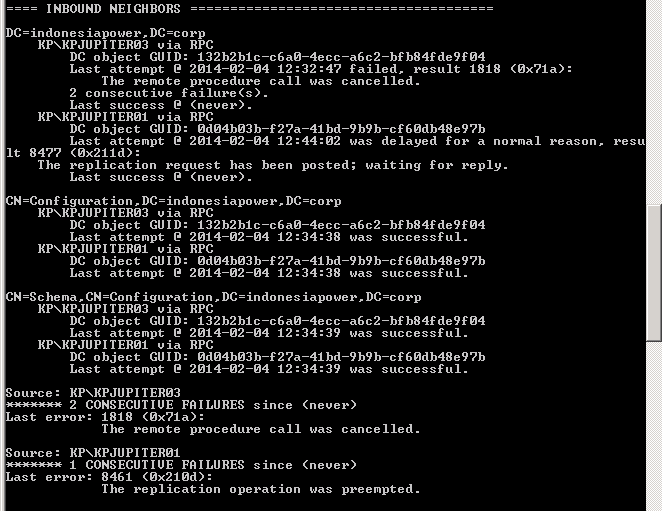The replication operation was preempted 8461 0x210d
Active Directory Replication Delays
Active Directory Replication Delays
The amount of time it takes for a change made to an Active Directory partition to be reflected on another domain controller is referred to as replication latency. Most standard service level agreements (SLAs) for Active Directory include replication delay as a critical indicate. End-users see replication delay as the maximum duration of time they must wait after the Help Desk makes a requested modification, such as a password reset.
For example, an IT organisation may desire new user accounts or password resets to take effect no later than 30 minutes after the service desk initiates the change.
Second, if we make changes to a user object in one site domain controller, those changes should be replicated to other site domain controllers based on the site cost value. However, this does not always happen due to replication delays, and it may take some time to replicate these changes to other site domain controllers.
Symptoms
The replication operation was preempted 8461 0x210d
DCDIAG reports that the Active Directory Replications test has failed with error status (8461): The replication operation was preempted. Sample error text from DCDIAG resembles the following:
Testing server: <site><DC name> Starting test: Replications * Replications Check REPLICATION LATENCY WARNING [Replications Check,<DC name>] This replication path was preempted by higher priority work. From <source DC> to <destination DC> Naming Context: DC=<DN path> The replication generated an error (8461): The replication operation was preempted. Replication of new changes along this path will be delayed. Progress is occurring normally on this path.
Symptom 2:
REPADMIN.EXE reports that the last replication attempt was delayed for a normal reason, result 8461 (0x210d).
Cause
The 8477 (The replication request has been posted; waiting for response) status is informative and represents a normal Active Directory replication operation, indicating that replication is currently in progress from the source but has not yet been applied to the destination Domain Controllers database replica. The occurrence of this event for a lengthy period of time, on the other hand, might indicate problems with Active Directory Replication on the Destination Domain Controller. Among the possible causes are:
- Performance-based issue
- CPU Utilization or Disk I/O for the amount of data that the domain controller is replicating
- High rate of change for objects in Active Directory Domain Services (AD DS)
- Third-Party utilities that may hamper or delay normal replication function
- Large Groups (Greater than 5000 Members) where Linked-value Replication isn’t enabled
- A recent modification to the Active Directory Schema where a sizeable number of schema attributes have been modified or indexed
- Small replication schedule window
- Too many partners
Resolution
This status does not indicate a failure condition. This is a temporary issue in many cases and there are no resolution steps required.
If the status 8477 never clears, there is a lot of work to do to determine the correct path to take. This issue requires advanced knowledge of multiple troubleshooting tools. It may be necessary to seek the help of Microsoft Support to assist with the data analysis process.
You will have to determine the cause before you implement any steps to resolve an underlying problem. The cause of the replication status 8461 can occur in any of the following scenarios:
- Transient condition
- Replication load
- Consistent Load
- Temporary Load
- Performance issue
- OS Performance
- Disk Performance
- Network Performance
Determine whether this is only a transient condition. Document the time that manual replication is initiated, and find the corresponding tasks in the repadmin /queue output. Sometime later, run repadmin /queue, and determine whether the manually initiated tasks are still present. If replication tasks are queued. Look at the currently running task, and investigate. Use event log data, repadmin output, and performance monitor to help isolate the cause of the problem. Determine how quickly updates are being processed and what rate of change.
Third-Party applications should be configured and tuned around performance and supportability best practices. Certain applications, if not configured around best practices for Active Directory Performance, may cause impact to normal Active Directory Domain Controller function.
Applications of note include (but aren’t limited to):
a. Virus Scanning Software
b. Monitoring Agents
c. Identity Synchronization and Management Applications
d. Backup Software and Agents
In Windows 2000 Server forests, linked-value replication is not available. Because an originating update must be made in a single database transaction, and because the realistic maximum for a single transaction is 5,000 values, Windows 2000 Server Active Directory does not handle membership of more than 5,000 values.
A group of this size provides a constraint for both the database write operation necessary to record a change to an attribute of that size and the network transfer of that much data. This is not the case in forests with Windows 2003 or higher functional levels with enabled linked-valued replication (LVR) for group memberships.
As the schema directory partition, attribute definitions are kept as attributeSchema objects. Changes to attributeSchema objects prevent other replication from occurring until the schema changes are completed.
The replication system initially checks to determine if the schema versions of the source and destination domain controllers coincide during replication of any directory partition other than the schema directory partition. If the versions differ, replication of the other directory partition is delayed until the schema directory partition is synchronised.
Modifying the schema with LDIFDE or customised binaries bundled with programmes (such as Microsoft Exchange, Operations Manager, and so on) may result in the addition of indexed attributes to the schema directory partition. In big databases, replication delays might occur depending on the magnitude of the update.
So, that’s all in this blog. I will meet you soon with next stuff .Have a nice day !!!
Recommended content
RODC Installation Guide- Step by step guide to install read only domain controller
RODC Filtered Attribute Set
Installing and configuring a RODC in Windows Server-2012
How to find the GUID of Domain Controller
Understanding Group Policy Preferences
Group Policy Verification Tool GPOTool Exe
Group Policy Health Check on Specific Domain Controller
Netlogon Folder in Active Directory
Custom Attributes in Active Directory
Tombstone Lifetime of My Active Directory Forest
Computers AD Site From the Command Line
Active Directory Database Integrity
Disabling and Enabling the Outbound Replication
DFS Replication Service Stopped Replication
Strict Replication Consistency
The replication operation failed because of a schema mismatch between the servers involved
Troubleshooting ad replication error 8418 the replication operation failed because of a schema mismatch between the servers
Replication information in txt file
Repadmin Replsummary
Enabling the outbound replication
Guys please don’t forget to like and share the post.Also join our WindowsTechno Community and where you can post your queries/doubts and our experts will address them .
You can also share the feedback on below windows techno email id.
If you have any questions feel free to contact us on admin@windowstechno.com also follow us on facebook@windowstechno to get updates about new blog posts.


